
History & Overview of Rhubarb
Rhubarb is a hardy perennial in the buckwheat family (Polygonaceae). There are many species of plants called rhubarb, and not all are botanically related to the edible type. Edible garden rhubarb, Rheum rhabarbarum, is also sometimes referred to as R. x hybridum or R. x cultorum, and the name R. rhaponticum (European rhubarb, a different species) is sometimes misapplied. The ancient Chinese used it as a medicinal herb over 5,000 years ago. Native to southern Siberia, it got its name from the Russians who grew it along the Rha River (now the Volga). For centuries it was traded alongside tea as a cure for stomach aches and fevers.
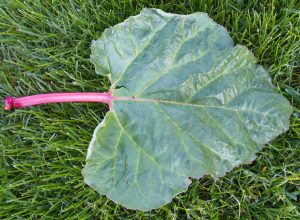
The English were the first to eat rhubarb, beginning in the 17th century, but unfortunately chose to begin with the leaves that look like chard. The leaves, however, contain a toxic amount of oxalic acid and are poisonous. The ensuing cramps, nausea and sometimes death from ingestion suppressed interest in the plant for about two hundred years. But by the late 18th century Europeans had discovered that the tart stalks were the part to eat – perfect for “tarts” giving rise to the nickname “pieplant.” It was brought to the Americas by settlers before 1800.
This herbaceous perennial grows 2 to 4 feet tall with large, smooth, heart-shaped basal leaves. The plant grows from large, fleshy reddish-brown rhizomes with yellow interiors. The leaves emerge from crown buds when temperatures begin to exceed 40ºF in early spring. The thick, succulent red or green leafstalks (petioles) grow up to 18 inches long and 1-2 inches in diameter, with leaf blades up to a foot or more in width. The foliage dies back to the ground each winter.

The hollow flower stalks emerge in summer directly from the crown with a few small, sessile (stalkless) leaves along the length. Each branched inflorescence has hundreds of small white flowers, each with six tepals and usually nine stamens with yellow or pinkish green, elliptical anthers, and three styles. The flowers are followed by dry, three-sided fruits (achenes) with winged sides which do not split open when ripe.

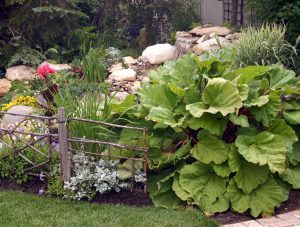
Landscape Use
Although usually relegated to the vegetable garden, the large leaves of rhubarb can make a bold statement in a sunny flower bed (there are many ornamental Rheum species as well) and is a great way to incorporate an edible plant into an ornamental planting. The big leaves provide coarse texture that contrasts nicely with other plants with fine or medium-textured foliage. Try combining rhubarb with ‘Husker Red’ penstemon, tall garden phlox, tall bearded iris, or ornamental grasses, such as feather reed grass.
General Care of Rhubarb
Rhubarb is very easy to grow. The plants like fertile, well-drained soil high in organic matter but are considered somewhat adaptable. Lighter soils will produce an earlier crop but require more irrigation and fertilization. Because this perennial will remain in the ground for several years, choose a site in full sun where it can remain undisturbed. Make sure to allow space for the large broad leaves to grow. Planting on raised beds for good drainage helps prevent crown rot. Prepare the planting site in the fall by eliminating perennial weeds and working in manure, compost or other organic matter. Incorporate fertilizer just before planting in the spring.

Plant purchased crown pieces or divisions from other plantings about 3 feet apart. Set the pieces so the buds are about 2 inches below the soil surface. Don’t harvest any stalks the first year; wait until the second or third year so the roots can establish themselves.
Fertilize established plants in the spring after growth starts with a complete garden fertilizer. Sidedress with nitrogen again in the summer after harvest. Maintain adequate soil moisture after the harvest season and remove flower stalks when they first appear to keep the leaves growing strongly. Keep grass and other competitors away from rhubarb. You may want to mulch in winter (after the ground freezes) to avoid heaving. Compost or rotted manure can also be applied to the soil in fall. Well-maintained plants have few pests. Slugs may be a problem in moist areas and crown rot may affect old clumps. Avoid crown rot by dividing clumps before they get too large. Leaf spots generally do not affect yield. Divide and reset plants about every fourth or fifth year to keep the plants vigorous.
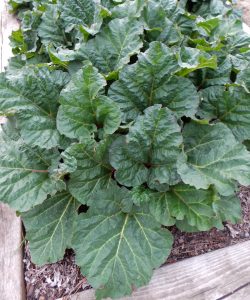
Propagating Rhubarb
Although rhubarb can be grown from seed, it is generally propagated by divisions taken in spring, about 4 to 6 weeks before the average date of last frost. Use a sharp spade or shovel to cut up the crown into pieces, with at least one strong bud for each piece. Instead of digging up the entire plant to divide it, you can just leave a portion with 3 to 4 buds undisturbed in the old location, and remove the remainder.
Rhubarb Cultivars
Rhubarb varieties are classified as red, green, or speckled (pink). Most people prefer the red stalked types, although the green ones are generally more productive. Red stemmed types are not necessarily sweeter because color and sweetness are not always related. In many cases, the same variety has acquired different names in different areas, as the plants get moved around, or with color variations, particularly for types grown from seed. Unnamed “heirloom” plants from backyards or abandoned farmsteads can be equally productive and delicious.
There are lots of named varieties; some of the most commonly recommended varieties include:
- ‘Canada Red’ often produces shorter, more slender stalks than other varieties but is tender and very sweet with good red color. It tends to produce few seed stalks.
- ‘Cherry Red’ (also known as ‘Cherry’ or ‘Early Cherry’) has long, thick stalks that are a rich red inside and out. This vigorous producer is juicy, tender and sweet.
- ‘Crimson Red’ (also called ‘Crimson’, ‘Crimson Cherry’, or ‘Crimson Wine’) produces tall, plump, brightly colored red stalks.
- ‘MacDonald’ produces well and has tender skin on the brilliant red stalks.
- ‘Valentine’ has broad, deep red stalks that retain a good rosy color when cooked. It is much less acid than green stalked and other red varieties and produces few or no seed stalks.
- ‘Victoria’ is a speckled type that produces medium-sized stalks of excellent quality and good flavor. Although there is some variation in stalk color depending on the strain, in general the light green stalks develop pink speckling, especially at the bottom of the stalk.
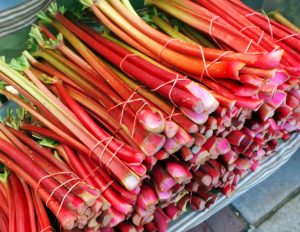
Culinary Uses
Rhubarb is typically used for jam, sauces, or in pies or other desserts but it also works well as an accompaniment to savory foods. Because rhubarb is tart it almost always needs to have sugar added to make it palatable. Rhubarb is most tender and flavorful in spring and early summer but can be used throughout the season.
Select firm, crisp stalks when they are 8 to 15 inches long. To harvest, twist off the leaf stalk at the soil line and cut off the leaf. Caution, as mentioned earlier, leaves contain oxalic acid and should not be eaten. Do not harvest more than a third of the leaves in any year to keep the plant going strong (and don’t pull any leaves during the first year of growth). If a hard late spring freeze occurred, do not harvest leafstalks as they will be of poor quality and oxalic acid may have moved into them from leaves.
On young plants, pick stalks only in the spring and allow them grow unpicked all summer, or growth will be delayed the following spring. You can harvest sparingly on vigorous, well-established plants throughout the summer. Any leaves remaining at the end of the season can be pulled just before the first fall frost. Store fresh rhubarb stalks unwashed in the refrigerator for up to two weeks. It will keep it the freezer for up to 6 months.
– Susan Mahr, University of Wisconsin – Madison
Last Update: Bruce Spangenberg, UW-Madison Extension, 2025





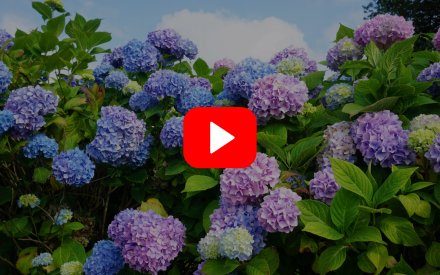 ▶︎ Watch: Hydrangeas: Know Them and Grow Them
▶︎ Watch: Hydrangeas: Know Them and Grow Them Aster, Symphyotrichum spp.
Aster, Symphyotrichum spp. Alternatives to Lawn: Groundcovers
Alternatives to Lawn: Groundcovers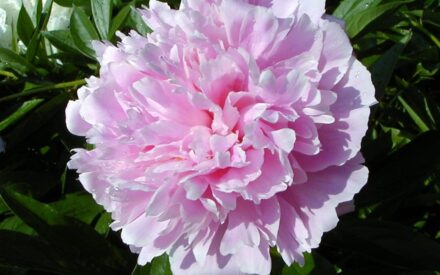 Peony
Peony


